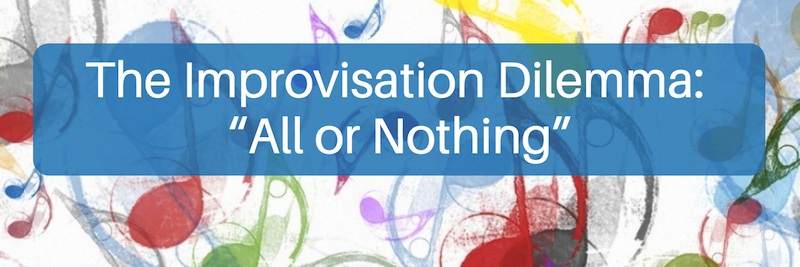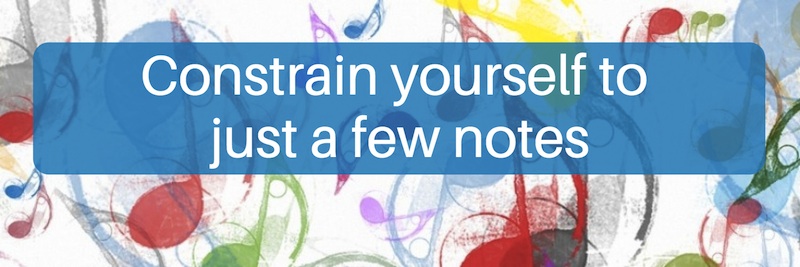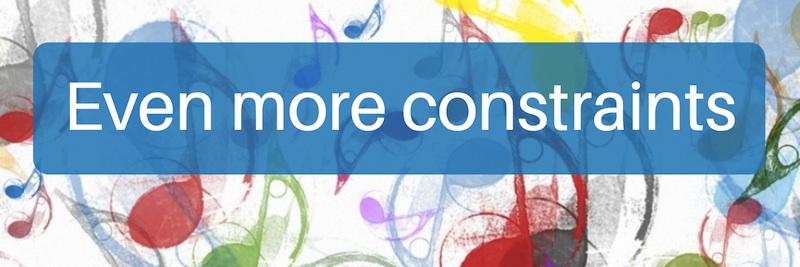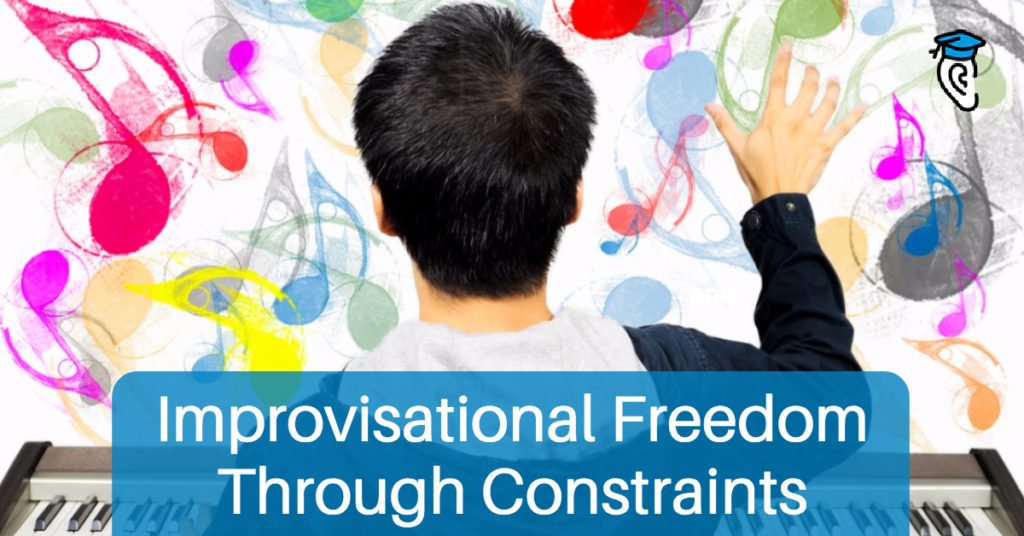Trying to improvise as a musician is overwhelming – or it’s boring. There are two approaches to improvisations musicians typically choose. One gives them so many options they don’t know what to play, and the other gives them so fixed a structure that they end up playing like a robot. Either way, the result rarely sounds musical. Fortunately there is an easy and effective way to learn to improvise musically.
Here’s the problem: if you or I sit down at a piano (for example) we might have the technical competence to play any combination of notes we can think of. You could choose any major or minor chord, pick any notes from any scale. The options for improvisation with 88 keys and ten fingers are overwhelming. Even on instruments which have a narrower range of options, the “you can play any possible note” mindset is intimidating.
So we don’t approach improvisation like that.
Instead, we choose a key. That gives us a smaller set of notes to work with. It also gives us a set of chords that will work well, such as I-IV-V-vi progressions.
Now our fingers have far fewer options and we can feel much more confident in which notes we choose but the improvisation can still be creative and interesting.
Choosing a key like this is adding a constraint to your improvisation, limiting the number of possibilities available to you – yet it actually frees you up to improvise more easily.
In this article, I’m going to suggest you take things a step further. Add more rules – and so gain even more freedom in improvisation.
It sounds counter-intuitive, but it really works.
We’ll look in a bit more detail at this dilemma of improvisation, and then the “more constraints” approach before digging into some practical examples you can apply in your own improvisation practice.

The Improvisation Dilemma: “All or Nothing”
Perhaps the biggest problem musicians have with improvisation is this issue of the “rules” for improvising. For many people (guitarists in particular) they quickly end up feeling trapped between two options:
Option 1: Ultimate Freedom
“Play whatever notes you like!”
“Just use your instinct!”
“If you’ve got a gift for music you’ll make great choices automatically!”
Sorry to put it bluntly – but this is ridiculous.
Yes, it is possible to improvise with no thought, relying on instinct. But that instinct (in 99% of cases) has been honed through active, thoughtful practice and training. So this is the end goal – not a beginner method.
If you try just blindly improvising with total freedom over which notes to pick, you’ll probably end up frustrated (and feeling a bit embarrassed) because you thought it was all meant to just come “naturally”.
This leads people to…
Option 2: Follow the rules
“Just use the notes of this scale and keep to basic rhythms.”
“Learn these riffs and licks in different keys and just play those as your solos.”
“Play these notes here and those ones there.”
This approach is particularly common with guitarists, who learn which fretboard pattern (i.e. scale) to use for their solos and then just meander up and down that pattern and call it improvisation.
You also see this approach in jazz instructional books like the ABRSM Jazz Piano series, where each bar of the “solo” section of the piece has a few suggested notes penciled in and you are meant to improvise using those notes in that bar.
This great advantage of this approach is: you won’t sound terrible. You’re mostly protected from the danger of playing “wrong” notes by restricting which ones you are “allowed” to use. That can be liberating. Throw in a few expressive twists like pitch bends or more interesting rhythms and it can actually sound pretty good!
But it’s not very fun or satisfying for the player. It always feels more like you’re a robot than a musician.
So what’s the solution? How can you have the confidence and safety of Option 2 with the true musical expression of Option 1?

Embrace constraints
If you’ve been using Option 2 and felt your solos getting stale, you’ve probably felt limited by the rules you’re following. Maybe it’s time for a new fretboard pattern, or perhaps you should start randomly introducing accidentals to the scale?
Unfortunately going that route tends to land you in Option 1 (too much freedom) or back in Option 2 again (just with different rules to strictly follow).
Surprisingly, the real way to escape Option 2 isn’t to add more freedom: it’s to add more constraints.
You see, the problem with Option 2 is that it typically still gives you too much freedom. You’re protected from playing “wrong” notes but you still have total freedom about which notes to play from the set you’ve chosen (normally 5-8 notes across a few octaves) and the rhythms to use. As a result, you actually end up with the curse of Option 1 within the framework of Option 2: you still have no real idea how to play a musically effective solo!
So how does adding more constraints help you? Surely that would just make you more robotic-sounding, wouldn’t it?
In fact, it doesn’t. By constraining yourself in varied and creative ways you actually give your inner musician a more reasonable task. Instead of being faced with a large set of notes and total rhythmic freedom, you narrow it down to the point where the options aren’t overwhelming – and your natural musicality can start to come out.
Let’s look at an example.

Example: Constrain yourself to just a few notes
It may sound crazy, but the solo you played last week using all the notes of the minor pentatonic spread across three octaves, with pitch bends and vibrato and clever use of wah-wah effects? It might have sounded a whole lot better to your audience if you’d used just three notes and no embellishments.
Next time you improvise, try using just three notes from the scale – or even two, as recently recommended in our Jazz Experts Improvisation Guide.
Note: If you play a percussive instrument, or you feel this doesn’t apply, keep reading! The concept will still work for your instrument. In fact there’s even a demonstration on drums below.
It’s generally best to start with the first (i.e. bottom) notes of the scale. So for example if you’re starting from a C Major scale, use C, D and (optionally) E.
Now your challenge is to see how creative you can be with just those three notes.
This helps you in four major ways:
1. It unleashes your instinct
You’re giving your inner musician a more reasonable set of options to consider when choosing the notes to play – and that musical instinct can actually start to do its work.
It’s a bit like how you use interval recognition in practice for improvisation and playing by ear: you first narrow down the possibilities and the task of identifying the notes becomes much easier.
If you’ve felt unmusical and lacking instinct when playing solos using the “Option 1” and “Option 2” approaches described above, this is going to be key for you.
Because if you’ve been learning music for a while then I guarantee you do have the inner sense of what does and doesn’t work in music. Restricting which notes you can play is going to let you start to connect with that inner sense of music and see how you can express your own ideas.
2. There’s Room for Rhythm
By restricting the note pitches you give yourself more mental capacity to think about rhythm. Normally you’re tied up wondering which of a dozen notes to play next and you typically end up either following very basic rhythms (e.g. just playing on each beat) or your rhythmic accuracy breaks down, as you’re too late or too early with each decision and hence each note.
Either way, your improvisation has poor rhythm.
Ella Fitzgerald’s One Note Samba doesn’t quite use just one note – but it’s a perfect demonstration of how restricting the note pitches can start to release your rhythmic potential.
3. You develop your Relative Pitch
When you spend minutes playing around with just a few notes, day after day, you begin to really know those notes well.
Not in a perfect pitch sense of recognising the C note, but in a relative pitch sense: you know that the first three notes of a major scale each have their own musical role.
You begin to get an instinctive feel for which notes you should start and finish a phrase on, and how the transitions between notes can each serve a different musical purpose.
This is something you have to experience because just reading about it will always sound like some kind of magical “gift”. But I assure you it isn’t.
Try improvisation practice with the first three notes (in solfa this is “do”, “re”, and “mi”) and after a few days you will start to hear in your head “Oh, I want to go to mi now”, or “Maybe ‘mi mi re mi re do’ would work well to end this solo”, and so on.
Improvising in this way is an easy, natural, and really fun way to develop your sense of relative pitch (and optionally your solfa skills too).
4. Repetition isn’t boring – in fact it’s Musical
With fewer notes to choose from you’re going to be forced to repeat yourself more. Not just with repeated notes, but you’ll find you naturally repeat little phrases and licks more than when using the full scale. This immediately makes your solo sound more musical and less random or robotic.
Think about it: all of music is built on repetition. The steady repeated pulse of each bar. The repeated melody in verses and choruses. The repeated chord progressions through a song. So why should your improvisation be any different?
You’ll often hear the advice that a great solo creates musical ideas and then plays with and develops them. That can seem like a pretty advanced technique, but when you’re forced to repeat yourself a bit more you will find it actually comes naturally. Instead of trying to play something different every bar, you learn to explore how little you can change each bar and still keep your solo interesting.

Even more constraints
Hopefully you’re starting to see how embracing constraints can actually give you more freedom and confidence in improvisation. If you try the exercise above I guarantee you’ll gain a new appreciation of your own inner musician who’s been waiting to come out through improvising.
So what else can you do to continue on this path?
The first thing is to simply extend that exercise. If you started out with the first three notes (do re mi), try it with a different set (e.g. do mi so, notes one, three and five). Play around with different combinations, getting to know the musical role each note plays in the scale.
To begin with do this once per exercise, using the same notes throughout your solo. Then, as you get confident, try mixing it up: Play the first 4 bars with one set of notes, then the next 4 bars with another.
Learn which sets of notes work well after each other and how to continue a melody or a musical idea from one to the other. Rhythm can be a great avenue there, where you keep the same rhythmic pattern but vary which notes you’re playing.
You can also add new kinds of constraint. For example, try challenging yourself to play syncopated rhythms only, or to use triplets in your improvisation. This tends to work best for just a bar or two rather than your whole solo, but for practice you might want to try doing it for longer periods.
Or you can set yourself structural challenges like “I’m going to create a little melody in bar 1, repeat it in bar 2, vary it slightly in bar 3 then return to it in bar 4”. Do that again and again, with a different seed idea each time.
Here’s a great tutorial video from The 80/20 Drummer about how to do this on the drum kit, challenging yourself to “orchestrate” your solo differently and so create variation in an intentional rather than random way. Worth watching whether you play percussion or not!
Gain Improvisational Freedom Through Constraints
I’ve explained how you can actually get more freedom and confidence when improvising by restricting your choices and following more constraints rather than fewer. You’ve seen several examples of rules you could apply, and a very simple starting point: a two-note solo.
As I said before though, this is the kind of thing that will only truly convince you when you try it. So next time you sit down with your instrument, give it a go. Put on a metronome, or better yet a backing track. Decide your rules, starting as simply (i.e. as constrained) as possible to begin with. And see how musical you can make your playing.
For a long time I found improvisation to be either overwhelming or boring, depending on whether I tried using no constraints or following set rules. It was only by adding new and more interesting constraints that I found my inner instinct for music started to come out, and I could start expressing my musical ideas naturally. It may sound strange but true improvisational freedom comes from constraints, so try adding a few to your next improv practice – and let your inner musician shine!


 Click to tweet
Click to tweet




